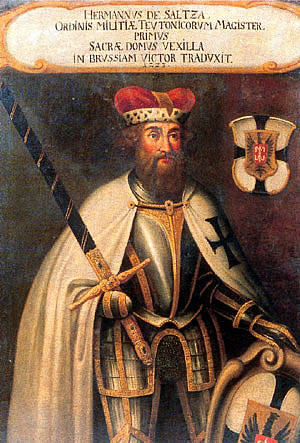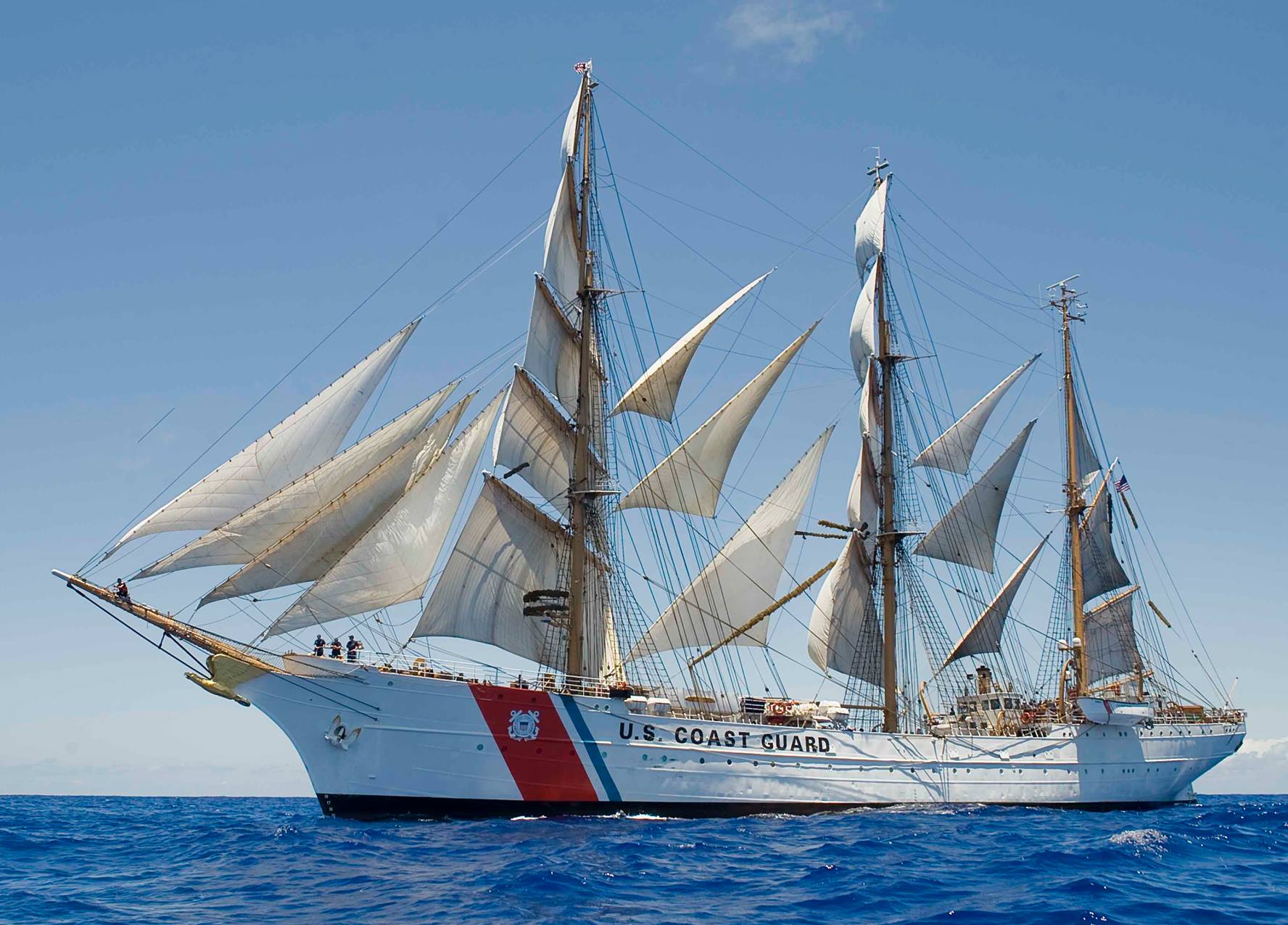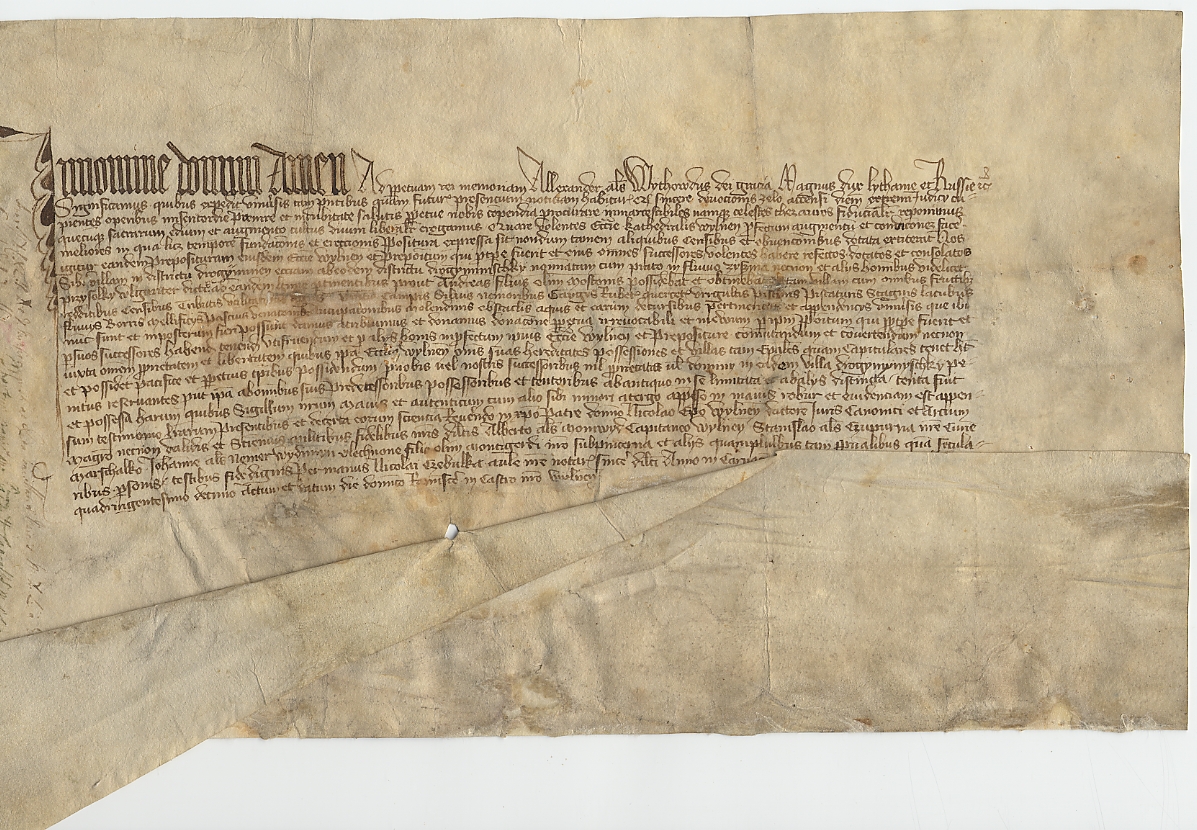|
Heinrich Von Plauen The Elder
Heinrich von Plauen (the Elder) ( – 1429) was the 27th Grand Master of the Teutonic Knights, serving from November 1410 to October 1413. Having becoming grandmaster in the wake of the Battle of Grunwald, he was a stern proponent of prolonging the war with Lithuania and Poland. Because all male members of his family were baptized as Heinrich (Henry), he is sometimes known as Heinrich von Plauen the Elder to differentiate from his relative, Heinrich von Plauen the Younger (died ca. 1441). Early career Von Plauen was born in Vogtland, between Thuringia and Saxony around 1370. He arrived in Prussia around 1390 as the Order's guest, but later became a full member. He did not hold any important positions until 1402 when he became the Komtur of Nessau (Nieszawa). He was promoted to Komtur of Schwetz (Świecie) in 1407. Von Plauen did not take part in the Battle of Grunwald on 15 July 1410. Upon receiving the news of the Order's defeat, he took the initiative and assembled an arm ... [...More Info...] [...Related Items...] OR: [Wikipedia] [Google] [Baidu] |
Hochmeister
The grand master of the Teutonic Order (; ) is the supreme head of the Teutonic Order. It is equivalent to the Grand master (order), grand master of other Military order (religious society), military orders and the superior general in non-military Religious order (Catholic), Roman Catholic religious orders. ''Hochmeister'', literally "high master", is only used in reference to the Teutonic Order, as ''Großmeister'' ("grand master") is used in German to refer to the leaders of other orders of knighthood. An early version of the full title in Latin was ''Magister Hospitalis Sanctae Mariae Alemanni, Alemannorum Hierosolymitani''. Since 1216, the full title ''Magister Hospitalis Domus Sanctae Mariae Teutons, Teutonicorum Hierosolymitani'' ("Master of the Hospital House of the Blessed Virgin Mary of the Germans of Jerusalem") was used. The offices of ''Hochmeister'' and ''Deutschmeister'' (''Magister Germaniae'') were united in 1525. The title of ''Magister Germaniae'' had been int ... [...More Info...] [...Related Items...] OR: [Wikipedia] [Google] [Baidu] |
Nieszawa
Nieszawa (Polish pronunciation: ) is a town and a commune in the Kuyavian-Pomeranian Voivodeship, in north-central Poland. As of June 30, 2014, the town has a population of 1,985 people. It is located in the historic region of Kuyavia. History The Statutes of Nieszawa, enacted in this town at 1454, have a significance in Polish legal and social history. Nieszawa was granted town rights in 1460. In the following centuries it was a royal city in Poland, royal town of the Crown of the Kingdom of Poland, Kingdom of Poland, administratively located in the Brześć Kujawski County in the Brześć Kujawski Voivodeship in the Greater Poland Province, Crown of the Kingdom of Poland, Greater Poland Province. According to the 1921 Polish census, 1921 census, the town had a population of 2,381, 90.7% Polish people, Polish and 7.4% Jews, Jewish. Following the joint German-Soviet invasion of Poland, which started World War II in September 1939, the town was invaded and then Occupation of Po ... [...More Info...] [...Related Items...] OR: [Wikipedia] [Google] [Baidu] |
War Indemnity
War reparations are compensation payments made after a war by one side to the other. They are intended to cover damage or injury inflicted during a war. War reparations can take the form of hard currency, precious metals, natural resources, industrial assets, or intellectual properties. Loss of territory in a peace settlement is usually considered to be distinct from war reparations. War reparations are often governed by treaties which belligerent parties negotiate as part of a peace settlement. Payment of reparations often occur as part of a condition to remove occupying troops or under the threat of re-occupation. The legal basis for war reparations in modern international law is Article 3 of the Hague Convention of 1907. Prominent examples of war reparations include Carthage's indemnity paid to Rome following the First Punic War, French reparations following the Napoleonic Wars, Haiti's reparations to France following the Haitian War of Independence (1791–1804), French ... [...More Info...] [...Related Items...] OR: [Wikipedia] [Google] [Baidu] |
Kuyavia
Kuyavia (; ), also referred to as Cuyavia, is a historical region in north-central Poland, situated on the left bank of Vistula, as well as east from Noteć River and Lake Gopło. It is divided into three traditional parts: north-western (with the capital in Bydgoszcz, ethnographically distinct), central (the capital in Inowrocław or Kruszwica), and south-eastern (the capital in Włocławek or Brześć Kujawski). Etymology The name Kuyavia first appeared in written sources in the 1136 Bull of Gniezno (, Latin: ''Ex commisso nobis'') issued by Pope Innocent II, and was then mentioned in many documents from medieval times. It is also mentioned in the chronicles of Wincenty Kadłubek. Geography and boundaries In the north, Kuyavia borders with the historic regions of Gdańsk Pomerania (Pomerelia) and Chełmno Land, in the west with proper (exact) Greater Poland, in the south with Łęczyca Land and in the east with Masovia and Dobrzyń Land. The borders of Kuyavia stretch out on th ... [...More Info...] [...Related Items...] OR: [Wikipedia] [Google] [Baidu] |
Dobrzyń Land
Dobrzyń Land () is a historical region in central-northern Poland. It lies northeast of the Vistula River, south of the Drwęca, and west of the Skrwa. The territory approximately corresponds with the present-day powiats of Lipno, Rypin, and half of Golub-Dobrzyń within the Kuyavian-Pomeranian Voivodeship, although it encompasses parts of other counties as well. Totally, it has about 3,000 km2 and 200,000 inhabitants. Its historic capital is Dobrzyń nad Wisłą, which gave its name to the entire region. Its largest town is Rypin. History The region became part of the emerging Polish state under duke Mieszko I of Poland (960–992). Upon the death of his descendant Duke Bolesław III Wrymouth in 1138, it was allocated to the newly established Duchy of Masovia, a provincial duchy of Poland. In his Prussian Crusade, Duke Konrad I of Masovia in 1228 established the Order of Dobrzyń of German knights (''fratribus militiae Christi in Prussia''), whom he vested with the ... [...More Info...] [...Related Items...] OR: [Wikipedia] [Google] [Baidu] |
Vytautas The Great
Vytautas the Great (; 27 October 1430) was a ruler of the Grand Duchy of Lithuania. He was also the prince of Grodno (1370–1382), prince of Lutsk (1387–1389), and the postulated king of the Hussites. In modern Lithuania, Vytautas is revered as a national hero and was an important figure in the national rebirth in the 19th century. ''Vytautas'' is a popular male given name in Lithuania. In commemoration of the 500-year anniversary of his death, Vytautas Magnus University was named after him. Monuments in his honour were built in many towns in independent Lithuania during the interwar period from 1918 to 1939. Vytautas knew and spoke the Lithuanian language with his cousin Jogaila. Struggle for power 1377–1384 Vytautas' uncle Algirdas had been Grand Duke of Lithuania until his death in 1377. Algirdas and Vytautas' father Kęstutis had ruled jointly in the form of diarchy, with Algirdas governing the east and Kęstutis the west, primarily responsible for defense again ... [...More Info...] [...Related Items...] OR: [Wikipedia] [Google] [Baidu] |
Samogitia
Samogitia, often known by its Lithuanian language, Lithuanian name ''Žemaitija'' (Samogitian language, Samogitian: ''Žemaitėjė''; see Samogitia#Etymology and alternative names, below for alternative and historical names) is one of the five cultural regions of Lithuania and formerly one of the two core administrative divisions of the Grand Duchy of Lithuania alongside Lithuania proper. Žemaitija is located in northwestern Lithuania. Its capital city is Telšiai and the largest city is Šiauliai (located on the border between Samogitia and Aukštaitija). Throughout centuries, Samogitia developed a separate culture featuring diverse architecture, folk costumes, dances, songs, traditions, and a distinct Samogitian language. Famous landmarks include Tauragė Castle, Plungė Manor and Hill of Crosses. Etymology and alternative names The region is primarily referred to by its Lithuanian name, ''Žemaitija'', in both local and national contexts. The Latin language, Latin-derived ... [...More Info...] [...Related Items...] OR: [Wikipedia] [Google] [Baidu] |
Peace Of Thorn (1411)
The (First) Peace of Thorn was a peace treaty formally ending the Polish–Lithuanian–Teutonic War between allied Poland during the Jagiellon dynasty, Kingdom of Poland and Grand Duchy of Lithuania on one side, and the Teutonic Knights on the other. It was signed on 1 February 1411 in Thorn (Toruń), one of the southernmost cities of the Monastic State of the Teutonic Knights. In historiography, the treaty is often portrayed as a diplomatic failure of Poland–Lithuania as they failed to capitalize on the decisive defeat of the Knights in the Battle of Grunwald in June 1410. The Knights returned Dobrzyń Land which they captured from Poland during the war and made only temporary territorial concessions in Samogitia, which returned to Lithuania only for the lifetimes of Polish King Władysław Jagiełło and Lithuanian Grand Duke Vytautas. The Peace of Thorn was not stable. It took two other brief wars, the Hunger War in 1414 and Gollub War in 1422, to sign the Treaty of Melno t ... [...More Info...] [...Related Items...] OR: [Wikipedia] [Google] [Baidu] |
Polish And Lithuanian Conflict With Prussia
Polish may refer to: * Anything from or related to Poland, a country in Europe * Polish language * Polish people, people from Poland or of Polish descent * Polish chicken * Polish brothers (Mark Polish and Michael Polish, born 1970), American twin screenwriters * Kevin Polish, an American Paralympian archer Polish may refer to: * Polishing, the process of creating a smooth and shiny surface by rubbing or chemical action ** French polishing, polishing wood to a high gloss finish * Nail polish * Shoe polish * Polish (screenwriting), improving a script in smaller ways than in a rewrite See also * * * Polishchuk (surname) * Polonaise (other) A polonaise ()) is a stately dance of Polish origin or a piece of music for this dance. Polonaise may also refer to: * Polonaises (Chopin), compositions by Frédéric Chopin ** Polonaise in A-flat major, Op. 53 (, ''Heroic Polonaise''; ) * Polon ... {{Disambiguation, surname Language and nationality disambiguation pages ... [...More Info...] [...Related Items...] OR: [Wikipedia] [Google] [Baidu] |
Elbląg
Elbląg (; ; ) is a city in the Warmian-Masurian Voivodeship, in northern Poland, located in the eastern edge of the Żuławy region with 127,390 inhabitants, as of December 2021. It is the capital of Elbląg County. Elbląg is one of the oldest cities in the province. Its history dates back to 1237, when the Teutonic Order constructed their fortified stronghold on the banks of a nearby river. The castle subsequently served as the official seat of the Teutonic Order Masters. Elbląg became part of the Hanseatic League, which contributed much to the city's wealth. Through the Hanseatic League, the city was linked to other major ports like Gdańsk, Lübeck and Amsterdam. Elbląg joined Poland in 1454 and after the defeat of the Teutonic Knights in the Thirteen Years’ War was recognized as part of Poland in 1466. It then flourished and turned into a significant trading point, but its growth was eventually hindered by the Second Northern War and the Swedish Deluge. The city ... [...More Info...] [...Related Items...] OR: [Wikipedia] [Google] [Baidu] |
Werner Von Tettingen
Werner may refer to: People * Werner (name), origin of the name and people with this name as surname and given name Fictional characters * Werner (comics), a German comic book character * Werner Von Croy, a fictional character in the ''Tomb Raider'' series * Werner von Strucker, a fictional character in the Marvel Comics universe * Werner, a fictional character in '' Darwin's Soldiers'' * Werner Ziegler, a fictional character from tv show Better Call Saul Geography * Werner, West Virginia * Mount Werner, a mountain that includes the Steamboat Ski Resort, in the Park Range of Colorado * Werner (crater), a crater in the south-central highlands of the Moon * Werner projection, an equal-area map projection preserving distances along parallels, central meridian and from the North pole Companies * Carsey-Werner, an American television and film production studio * Werner Enterprises, a Nebraska-based trucking company * Werner Co., a manufacturer of ladders * Werner Motors, an early ... [...More Info...] [...Related Items...] OR: [Wikipedia] [Google] [Baidu] |
Livonian Order
The Livonian Order was an autonomous branch of the Teutonic Order, formed in 1237. From 1435 to 1561 it was a member of the Livonian Confederation. History The order was formed from the remnants of the Livonian Brothers of the Sword after their defeat by Samogitians in 1236 at the Battle of Saule, Battle of Schaulen (Saule). They were incorporated into the Teutonic Knights and became known as the Livonian Order in 1237. In the summer of that year, the Master of Prussia Hermann Balk rode into Riga to install his men as castle commanders and administrators of Livonia. In 1238, the Teutonic Knights of Livonia signed the Treaty of Stensby with the Denmark, Kingdom of Denmark. Under this agreement, Denmark would support the expansion ambitions of the order in exchange for northern maritime Estonia. In 1242, the Livonian Order tried to take the city of Veliky Novgorod, Novgorod. However, they were defeated by Alexander Nevsky in the Battle on the Ice. Fortresses as Paide in land c ... [...More Info...] [...Related Items...] OR: [Wikipedia] [Google] [Baidu] |




